2003 FORD MUSTANG jump start
[x] Cancel search: jump startPage 2 of 256

Brakes 138
Traction control/AdvanceTrac 142
Transmission operation 144
Vehicle loading 154
Trailer towing 156
Roadside Emergencies 157
Getting roadside assistance 157
Hazard flasher switch 158
Fuel pump shut-off switch 159
Fuses and relays 160
Changing tires 165
Jump starting 170
Wrecker towing 175
Customer Assistance 176
Reporting safety defects (U.S. only) 186
Cleaning 187
Maintenance and Specifications 194
Engine compartment 197
Engine oil 199
Battery 203
Fuel information 214
Part numbers 237
Refill capacities 238
Lubricant specifications 240
Accessories 245
Index 248
All rights reserved. Reproduction by any means, electronic or
mechanical including photocopying, recording or by any
information storage and retrieval system or translation in
whole or part is not permitted without written authorization
from Ford Motor Company. Ford may change the contents
without notice and without incurring obligation.
Copyright © 2002 Ford Motor Company
Table of Contents
2
Page 157 of 256
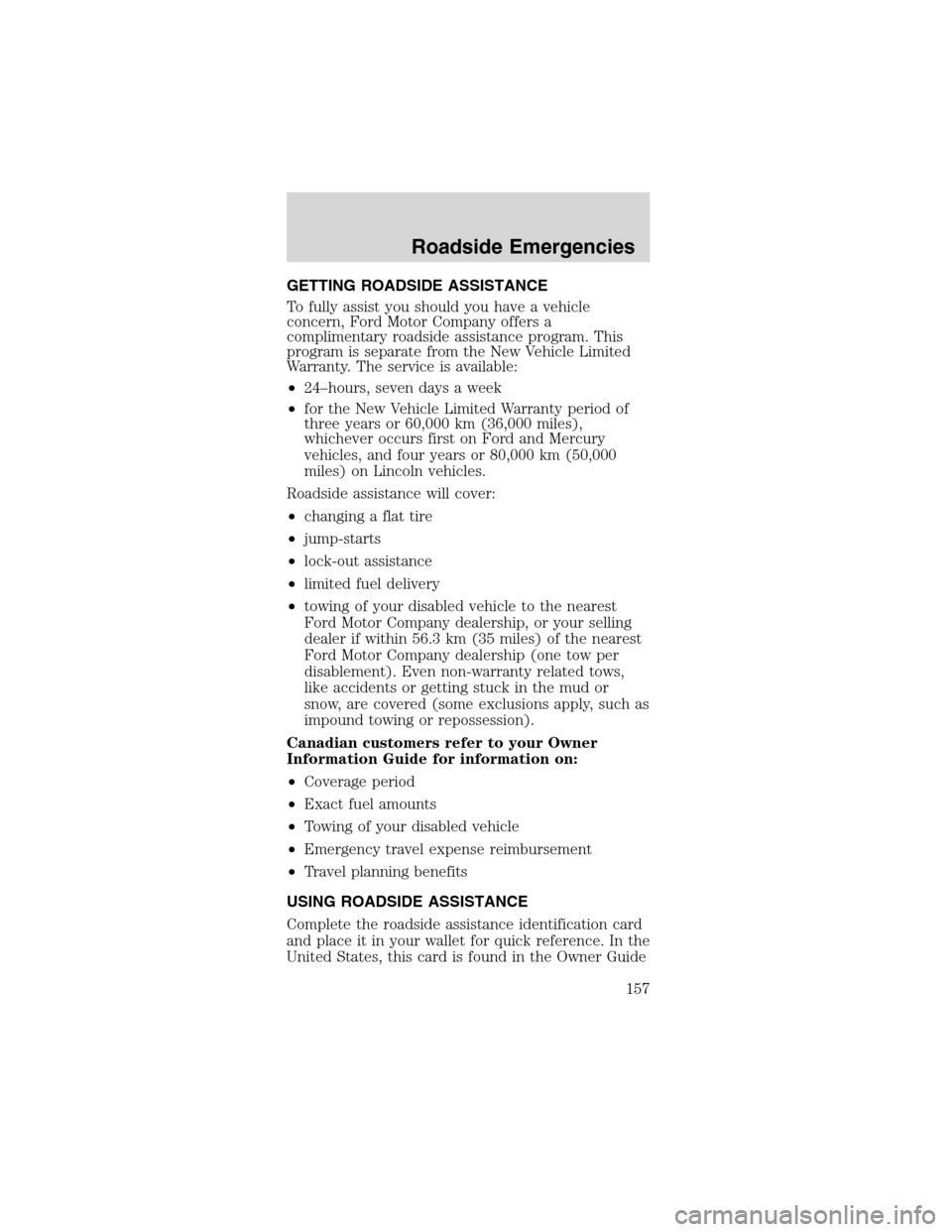
GETTINGROADSIDEASSISTANCE
To fully assist you should you have a vehicle
concern, Ford Motor Company offers a
complimentary roadside assistance program. This
program is separate from the New Vehicle Limited
Warranty. The service is available:
•24–hours, seven days a week
•for the New Vehicle Limited Warranty period of
three years or 60,000 km (36,000 miles),
whichever occurs first on Ford and Mercury
vehicles, and four years or 80,000 km (50,000
miles) on Lincoln vehicles.
Roadside assistance will cover:
•changing a flat tire
•jump-starts
•lock-out assistance
•limited fuel delivery
•towing of your disabled vehicle to the nearest
Ford Motor Company dealership, or your selling
dealer if within 56.3 km (35 miles) of the nearest
Ford Motor Company dealership (one tow per
disablement). Even non-warranty related tows,
like accidents or getting stuck in the mud or
snow, are covered (some exclusions apply, such as
impound towing or repossession).
Canadian customers refer to your Owner
Information Guide for information on:
•Coverage period
•Exact fuel amounts
•Towing of your disabled vehicle
•Emergency travel expense reimbursement
•Travel planning benefits
USING ROADSIDE ASSISTANCE
Complete the roadside assistance identification card
and place it in your wallet for quick reference. In the
United States, this card is found in the Owner Guide
Roadside Emergencies
157
Page 170 of 256
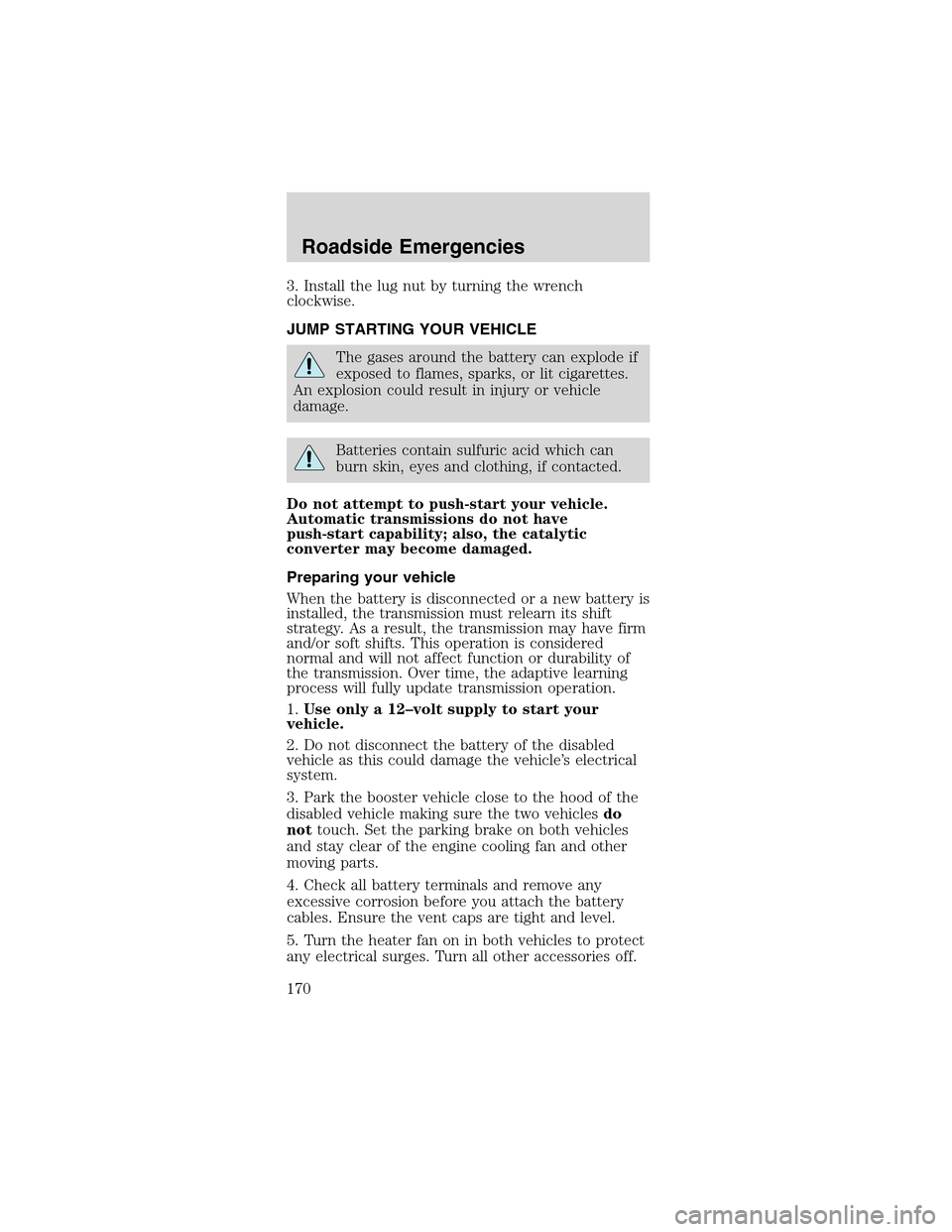
3. Install the lug nut by turning the wrench
clockwise.
JUMP STARTING YOUR VEHICLE
The gases around the battery can explode if
exposed to flames, sparks, or lit cigarettes.
An explosion could result in injury or vehicle
damage.
Batteries contain sulfuric acid which can
burn skin, eyes and clothing, if contacted.
Do not attempt to push-start your vehicle.
Automatic transmissions do not have
push-start capability; also, the catalytic
converter may become damaged.
Preparing your vehicle
When the battery is disconnected or a new battery is
installed, the transmission must relearn its shift
strategy. As a result, the transmission may have firm
and/or soft shifts. This operation is considered
normal and will not affect function or durability of
the transmission. Over time, the adaptive learning
process will fully update transmission operation.
1.Use only a 12–volt supply to start your
vehicle.
2. Do not disconnect the battery of the disabled
vehicle as this could damage the vehicle’s electrical
system.
3. Park the booster vehicle close to the hood of the
disabled vehicle making sure the two vehiclesdo
nottouch. Set the parking brake on both vehicles
and stay clear of the engine cooling fan and other
moving parts.
4. Check all battery terminals and remove any
excessive corrosion before you attach the battery
cables. Ensure the vent caps are tight and level.
5. Turn the heater fan on in both vehicles to protect
any electrical surges. Turn all other accessories off.
Roadside Emergencies
170
Page 172 of 256
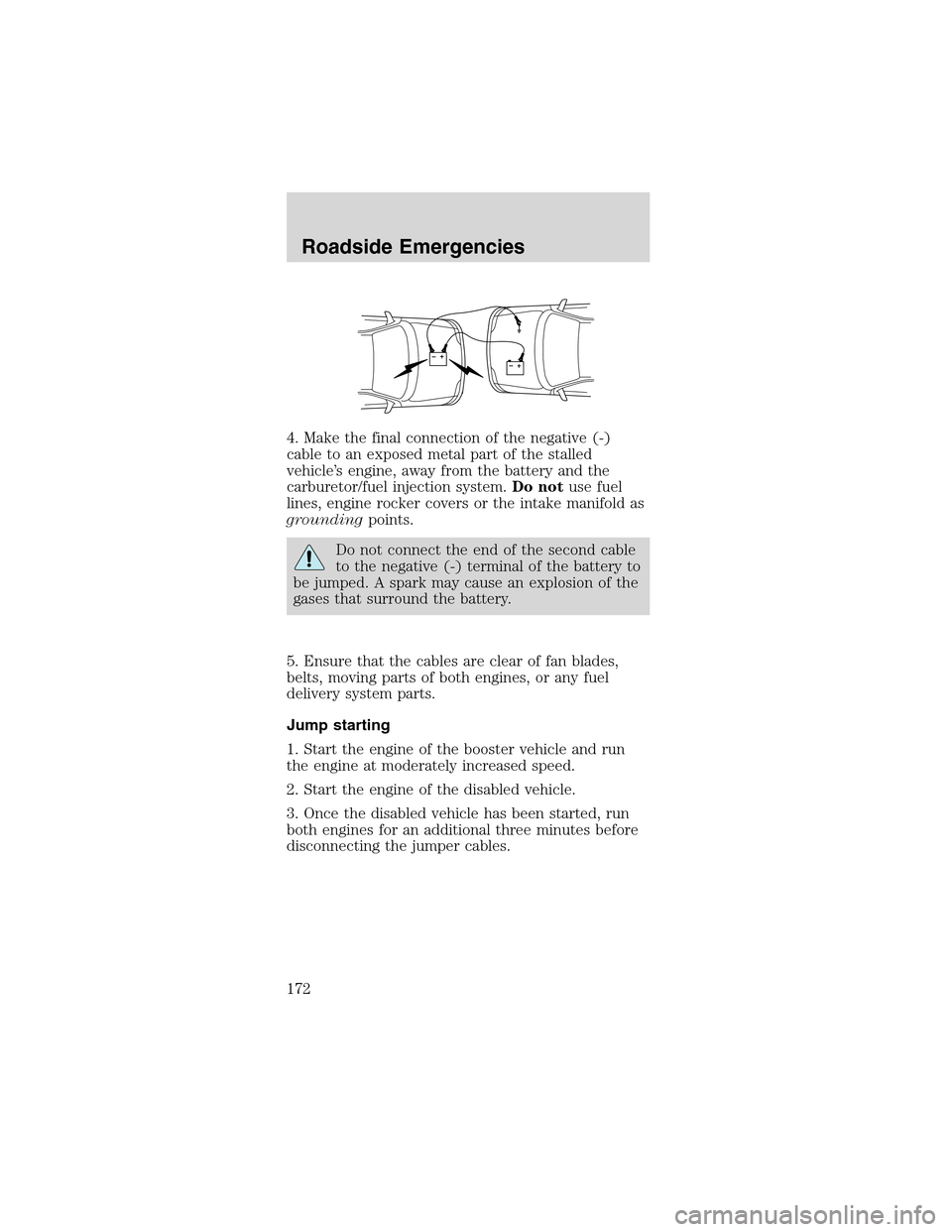
4. Make the final connection of the negative (-)
cable to an exposed metal part of the stalled
vehicle’s engine, away from the battery and the
carburetor/fuel injection system.Do notuse fuel
lines, engine rocker covers or the intake manifold as
groundingpoints.
Do not connect the end of the second cable
to the negative (-) terminal of the battery to
be jumped. A spark may cause an explosion of the
gases that surround the battery.
5. Ensure that the cables are clear of fan blades,
belts, moving parts of both engines, or any fuel
delivery system parts.
Jump starting
1. Start the engine of the booster vehicle and run
the engine at moderately increased speed.
2. Start the engine of the disabled vehicle.
3. Once the disabled vehicle has been started, run
both engines for an additional three minutes before
disconnecting the jumper cables.
+–+–
Roadside Emergencies
172
Page 174 of 256
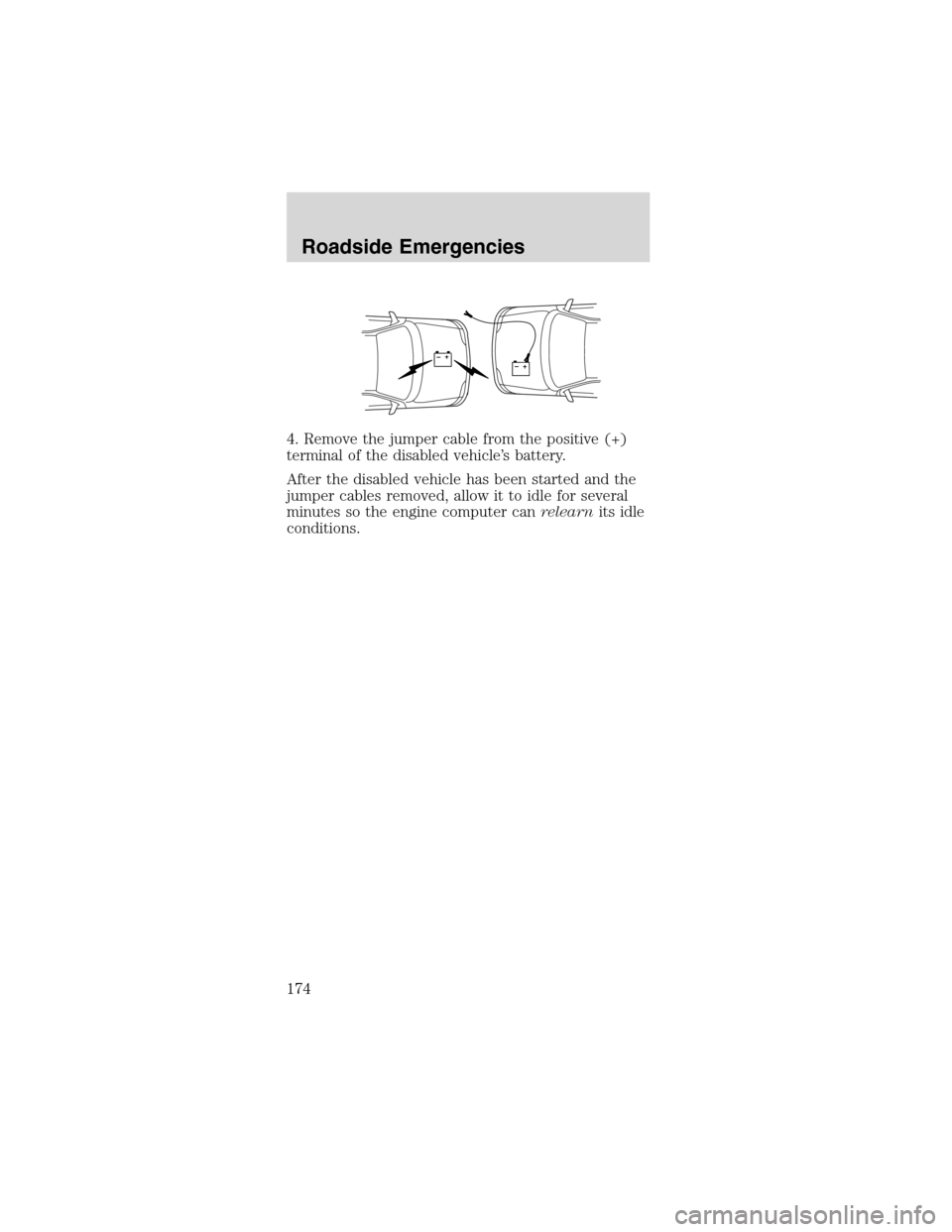
4. Remove the jumper cable from the positive (+)
terminal of the disabled vehicle’s battery.
After the disabled vehicle has been started and the
jumper cables removed, allow it to idle for several
minutes so the engine computer canrelearnits idle
conditions.
+–+–
Roadside Emergencies
174
Page 250 of 256
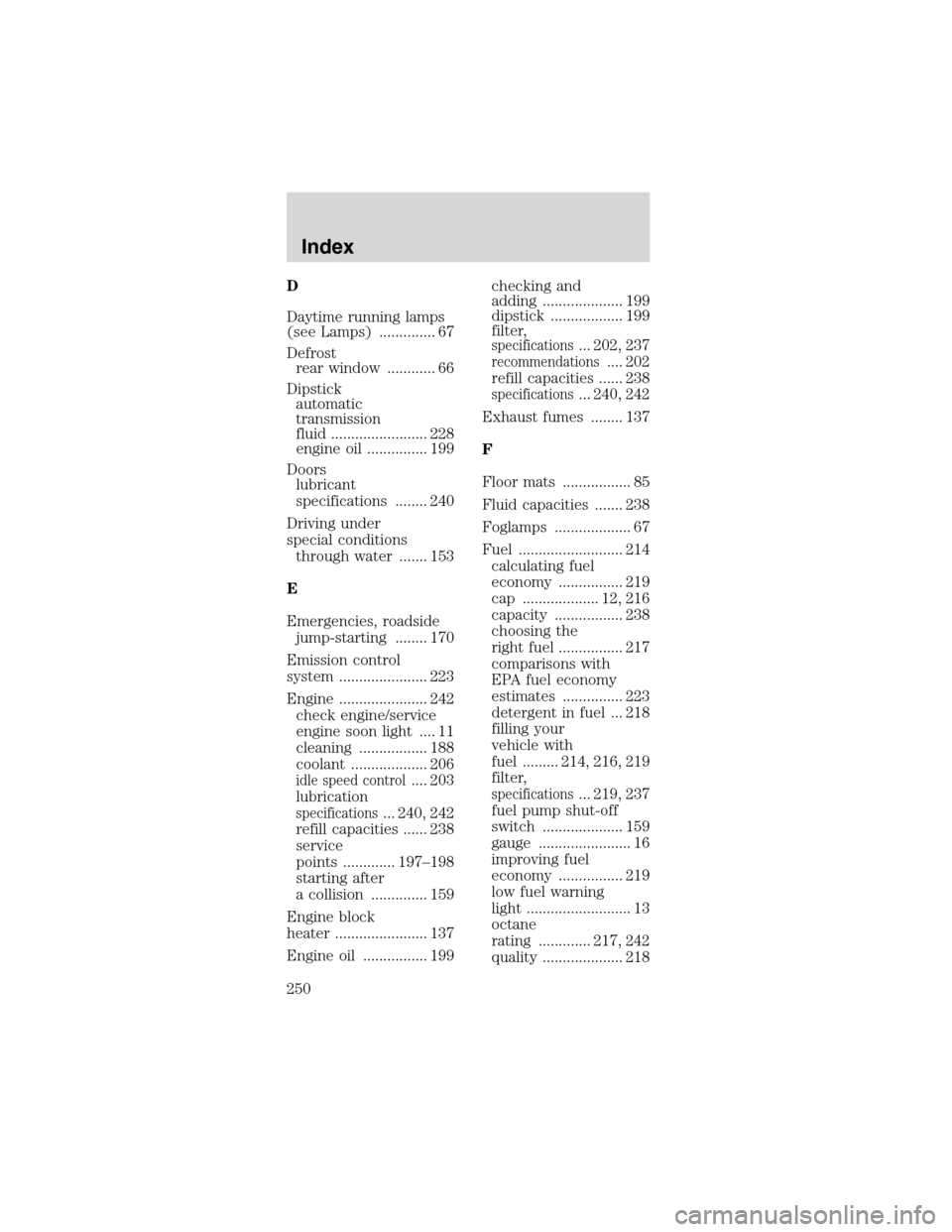
D
Daytime running lamps
(see Lamps) .............. 67
Defrost
rear window ............ 66
Dipstick
automatic
transmission
fluid ........................ 228
engine oil ............... 199
Doors
lubricant
specifications ........ 240
Driving under
special conditions
through water ....... 153
E
Emergencies, roadside
jump-starting ........ 170
Emission control
system ...................... 223
Engine ...................... 242
check engine/service
engine soon light .... 11
cleaning ................. 188
coolant ................... 206
idle speed control.... 203
lubrication
specifications... 240, 242
refill capacities ...... 238
service
points ............. 197–198
starting after
a collision .............. 159
Engine block
heater ....................... 137
Engine oil ................ 199checking and
adding .................... 199
dipstick .................. 199
filter,
specifications... 202, 237
recommendations.... 202
refill capacities ...... 238
specifications... 240, 242
Exhaust fumes ........ 137
F
Floor mats ................. 85
Fluid capacities ....... 238
Foglamps ................... 67
Fuel .......................... 214
calculating fuel
economy ................ 219
cap ................... 12, 216
capacity ................. 238
choosing the
right fuel ................ 217
comparisons with
EPA fuel economy
estimates ............... 223
detergent in fuel ... 218
filling your
vehicle with
fuel ......... 214, 216, 219
filter,
specifications... 219, 237
fuel pump shut-off
switch .................... 159
gauge ....................... 16
improving fuel
economy ................ 219
low fuel warning
light .......................... 13
octane
rating ............. 217, 242
quality .................... 218
Index
250
Page 252 of 256
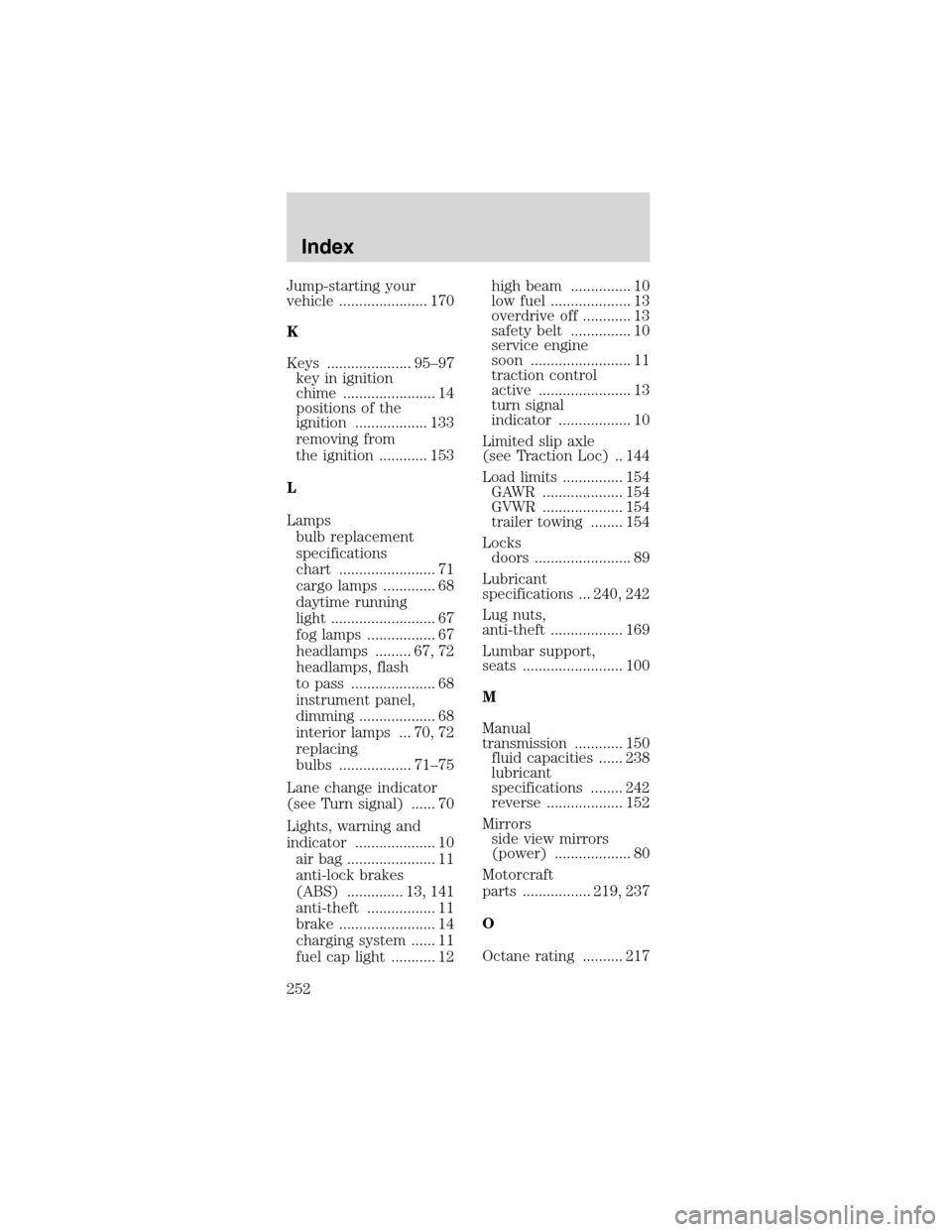
Jump-starting your
vehicle ...................... 170
K
Keys ..................... 95–97
key in ignition
chime ....................... 14
positions of the
ignition .................. 133
removing from
the ignition ............ 153
L
Lamps
bulb replacement
specifications
chart ........................ 71
cargo lamps ............. 68
daytime running
light .......................... 67
fog lamps ................. 67
headlamps ......... 67, 72
headlamps, flash
to pass ..................... 68
instrument panel,
dimming ................... 68
interior lamps ... 70, 72
replacing
bulbs .................. 71–75
Lane change indicator
(see Turn signal) ...... 70
Lights, warning and
indicator .................... 10
air bag ...................... 11
anti-lock brakes
(ABS) .............. 13, 141
anti-theft ................. 11
brake ........................ 14
charging system ...... 11
fuel cap light ........... 12high beam ............... 10
low fuel .................... 13
overdrive off ............ 13
safety belt ............... 10
service engine
soon ......................... 11
traction control
active ....................... 13
turn signal
indicator .................. 10
Limited slip axle
(see Traction Loc) .. 144
Load limits ............... 154
GAWR .................... 154
GVWR .................... 154
trailer towing ........ 154
Locks
doors ........................ 89
Lubricant
specifications ... 240, 242
Lug nuts,
anti-theft .................. 169
Lumbar support,
seats ......................... 100
M
Manual
transmission ............ 150
fluid capacities ...... 238
lubricant
specifications ........ 242
reverse ................... 152
Mirrors
side view mirrors
(power) ................... 80
Motorcraft
parts ................. 219, 237
O
Octane rating .......... 217
Index
252
Page 254 of 256

Servicing your
vehicle ...................... 194
Spare tire
(see Changing
the Tire) .................. 165
Spark plugs,
specifications ... 237, 242
Specification chart,
lubricants ......... 240, 242
Speed control ............ 80
Speedometer ............. 17
Starting your
vehicle ...... 133–134, 136
jump starting ........ 170
Steering wheel
controls .............. 77, 80
tilting ....................... 77
T
Tachometer ............... 17
Tires ......... 165, 232–234
changing ........ 165–166
checking the
pressure ................. 234
replacing ................ 235
rotating .................. 234
snow tires and
chains .................... 236
tire grades ............. 233
treadwear .............. 232
Towing ..................... 156
recreational
towing .................... 156
trailer towing ........ 156
wrecker .................. 175
Traction control ...... 142
active light .............. 13Traction-lok rear
axle .......................... 144
Transmission
automatic
operation ............... 144
fluid, checking
and adding
(automatic) ........... 228
fluid, checking
and adding
(manual) ............... 231
fluid, refill
capacities ............... 238
lubricant
specifications... 240, 242
manual operation .. 150
Trip odometer ........... 18
Trunk ......................... 89
remote release .. 85, 93
Turn signal .......... 10, 70
V
Vehicle dimensions . 242
Vehicle Identification
Number (VIN) ......... 244
Vehicle loading ........ 154
Ventilating your
vehicle ...................... 138
W
Warning chimes ... 14–15
Warning lights
(see Lights) ............... 10
Washer fluid ............ 199
Water, Driving
through .................... 153
Index
254